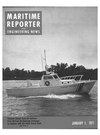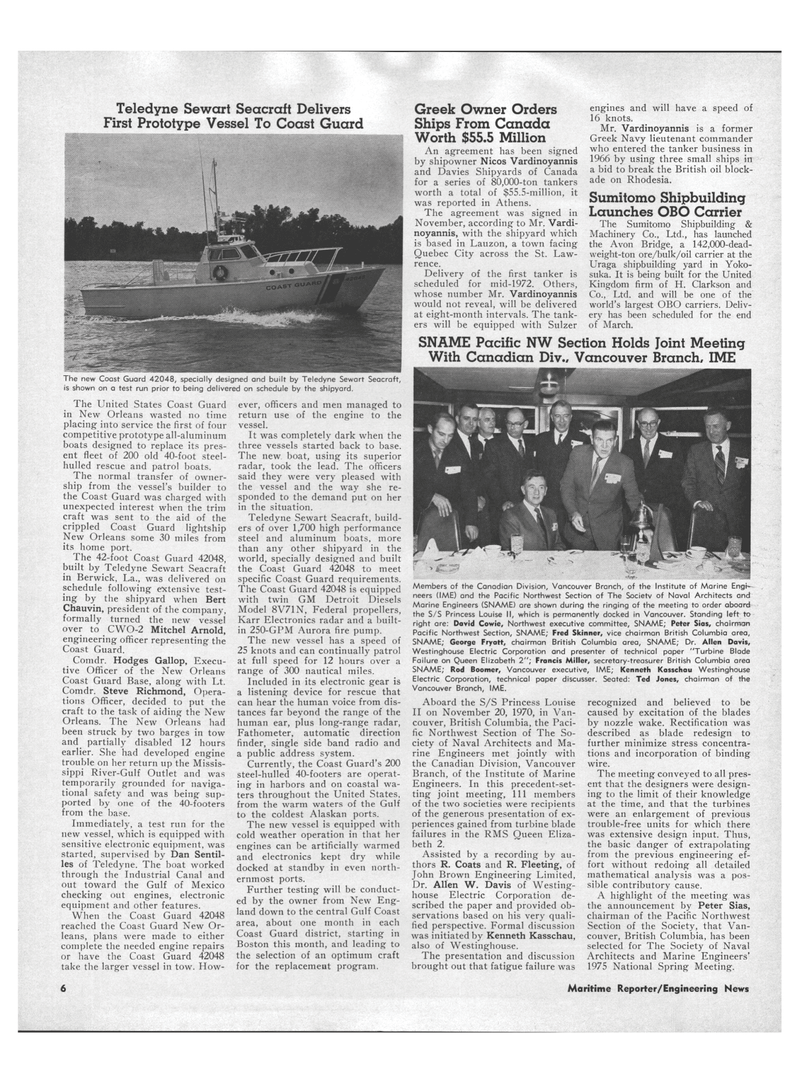
Page 4: of Maritime Reporter Magazine (January 1971)
Read this page in Pdf, Flash or Html5 edition of January 1971 Maritime Reporter Magazine
SNAME Pacific NW Section Holds Joint Meeting
With Canadian Div., Vancouver Branch, IME
The new Coast Guard 42048, specially designed and built by Teledyne Sewart Seacraft, is shown on a test run prior to being delivered on schedule by the shipyard. engines and will have a speed of 16 knots.
Mr. Vardinoyannis is a former
Greek Navy lieutenant commander who entered the tanker business in 1966 by using three small ships in a bid to break the British oil block- ade on Rhodesia.
Sumitomo Shipbuilding
Launches OBO Carrier
The Sumitomo Shipbuilding &
Machinery Co., Ltd., has launched the Avon Bridge, a 142,000-dead- weight-ton ore/bulk/oil carrier at the
Uraga shipbuilding yard in Yoko- suka. It is being built for the United
Kingdom firm of H. Clarkson and
Co., Ltd. and will be one of the world's largest OBO carriers. Deliv- ery has been scheduled for the end of March.
The United States Coast Guard in New Orleans wasted no time placing into service the first of four competitive prototype all-aluminum boats designed to replace its pres- ent fleet of 200 old 40-foot steel- hulled rescue and patrol boats.
The normal transfer of owner- ship from the vessel's builder to the Coast Guard was charged with unexpected interest when the trim craft was sent to the aid of the crippled Coast Guard lightship
New Orleans some 30 miles from its home port.
The 42-foot Coast Guard 42048, built by Teledyne Sewart Seacraft in Berwick, La., was delivered on schedule following extensive test- ing by the shipyard when Bert
Chauvin, president of the company, formally turned the new vessel over to CWO-2 Mitchel Arnold, engineering officer representing the
Coast Guard.
Comdr. Hodges Gallop, Execu- tive Officer of the New Orleans
Coast Guard Base, along with Lt.
Comdr. Steve Richmond, Opera- tions Officer, decided to put the craft to the task of aiding the New
Orleans. The New Orleans had been struck by two barges in tow and partially disabled 12 hours earlier. She had developed engine trouble on her return up the Missis- sippi River-Gulf Outlet and was temporarily grounded for naviga- tional safety and was being sup- ported by one of the 40-footers from the base.
Immediately, a test run for the new vessel, which is equipped with sensitive electronic equipment, was started, supervised by Dan Sentil- les of Teledyne. The boat worked through the Industrial Canal and out toward the Gulf of Mexico checking out engines, electronic equipment and other features.
When the Coast Guard 42048 reached the Coast Guard New Or- leans, plans were made to either complete the needed engine repairs or have the Coast Guard 42048 take the larger vessel in tow. How- ever, officers and men managed to return use of the engine to the vessel.
It was completely dark when the three vessels started back to base.
The new boat, using its superior radar, took the lead. The officers said they were very pleased with the vessel and the way she re- sponded to the demand put on her in the situation.
Teledyne Sewart Seacraft, build- ers of over 1,700 high performance steel and aluminum boats, more than any other shipyard in the world, specially designed and built the Coast Guard 42048 to meet specific Coast Guard requirements.
The Coast Guard 42048 is equipped with twin GM Detroit Diesels
Model 8V71N, Federal propellers,
Karr Electronics radar and a built- in 250-GPM Aurora fire pump.
The new vessel has a speed of 25 knots and can continually patrol at full speed for 12 hours over a range of 300 nautical miles.
Included in its electronic gear is a listening device for rescue that can hear the human voice from dis- tances far beyond the range of the human ear, plus long-range radar,
Fathometer, automatic direction finder, single side band radio and a public address system.
Currently, the Coast Guard's 200 steel-hulled 40-footers are operat- ing in harbors and on coastal wa- ters throughout the United States, from the warm waters of the Gulf to the coldest Alaskan ports.
The new vessel is equipped with cold weather operation in that her engines can be artificially warmed and electronics kept dry while docked at standby in even north- ernmost ports.
Further testing will be conduct- ed by the owner from New Eng- land down to the central Gulf Coast area, about one month in each
Coast Guard district, starting in
Boston this month, and leading to the selection of an optimum craft for the replacement program.
Members of the Canadian Division, Vancouver Branch, of the Institute of Marine Engi- neers (IME) and the Pacific Northwest Section of The Societv of Naval Architects and
Marine Engineers (SNAME) are shown during the ringing of the meeting to order aboard the S/S Princess Louise II, which is permanently docked in Vancouver. Standing left to right are: David Cowie, Northwest executive committee, SNAME; Peter Sias, chairman
Pacific Northwest Section, SNAME; Fred Skinner, vice chairman British Columbia area,
SNAME; George Fryott, chairman British Columbia area, SNAME; Dr. Allen Davis,
Westinghouse Electric Corporation and presenter of technical paper "Turbine Blade
Failure on Queen Elizabeth 2"; Francis Miller, secretary-treasurer British Columbia area
SNAME; Rod Boomer, Vancouver executive, IME; Kenneth Kasschau Westinghouse
Electric Corporation, technical paper discusser. Seated: Ted Jones, chairman of the
Vancouver Branch, IME.
Aboard the S/S Princess Louise
II on November 20, 1970, in Van- couver, British Columbia, the Paci- fic Northwest Section of The So- ciety of Naval Architects and Ma- rine Engineers met jointly with the Canadian Division, Vancouver
Branch, of the Institute of Marine
Engineers. In this precedent-set- ting joint meeting, 111 members of the two societies were recipients of the generous presentation of ex- periences gained from turbine blade failures in the RMS Queen Eliza- beth 2.
Assisted by a recording by au- thors R. Coats and R. Fleeting, of
John Brown Engineering Limited,
Dr. Allen W. Davis of Westing- house Electric Corporation de- scribed the paper and provided ob- servations based on his very quali- fied perspective. Formal discussion was initiated by Kenneth Kasschau, also of Westinghouse.
The presentation and discussion brought out that fatigue failure was recognized and believed to be caused by excitation of the blades by nozzle wake. Rectification was described as blade redesign to further minimize stress concentra- tions and incorporation of binding wire.
The meeting conveyed to all pres- ent that the designers were design- ing to the limit of their knowledge at the time, and that the turbines were an enlargement of previous trouble-free units for which there was extensive design input. Thus, the basic danger of extrapolating from the previous engineering ef- fort without redoing all detailed mathematical analysis was a pos- sible contributory cause.
A highlight of the meeting was the announcement by Peter Sias, chairman of the Pacific Northwest
Section of the Society, that Van- couver, British Columbia, has been selected for The Society of Naval
Architects and Marine Engineers' 1975 National Spring Meeting.
Teledyne Sewart Seacraft Delivers
First Prototype Vessel To Coast Guard
Greek Owner Orders
Ships From Canada
Worth $55.5 Million
An agreement has been signed by shipowner Nicos Vardinoyannis and Davies Shipyards of Canada for a series of 80,000-ton tankers worth a total of $55.5-million, it was reported in Athens.
The agreement was signed in
November, according to Mr. Vardi- noyannis, with the shipyard which is based in Lauzon, a town facing
Quebec City across the St. Law- rence.
Delivery of the first tanker is scheduled for mid-1972. Others, whose number Mr. Vardinoyannis would not reveal, will be delivered at eight-month intervals. The tank- ers will be equipped with Sulzer 6 Maritime Reporter/Engineering Hews

 3
3

 5
5
